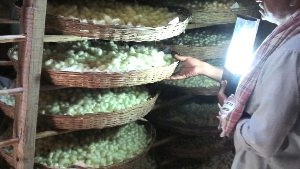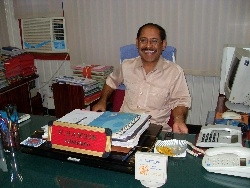
Indian Solar Loan Program Offers Access
to Light
Aug 8, 2008 - Peter Fries - RenewableEnergyWorld.com
 |
| Photo Credit: Peter Fries |
Bangalore - If you live in a rural area of southern India,
two lights can literally save your life.
Just ask Vinoj Kanaya, farmer of silkworms who lives outside
a small village located 250 kilometers from the new Silicon
Valley of Bangalore. Like many people in developing countries,
Mr Kanaya wanted something better than burning wood, dung
or kerosene for which he paid a higher proportion of his
income than someone in a developed country.
|
"We didn't want a technician driving 200 kilometers
from Bangalore to service a system," says Kumar. Such
rigorous standards, he says gives the banks and customers
confidence. "If the solar system stops working, the
customer stops paying the loan."
-- Mr. H. V. Kumar, Crestar Capital
|
|
After he installed two solar-powered lights with the help
of a solar loan, Kanaya says attacks by deadly cobras have
gone down because the snakes are scared off by the brighter
solar light. The lights are much cheaper to run than those
powered by kerosene and there are fewer accidents and burns
with solar lights. Kanaya says that both his helpers and
his silkworms work much better without the smoke and fumes
of kerosene lamps.
But with an annual income of just US $2,000 to support
seven people, the initial US $300 cost of the solar lights
was simply too expensive. Too expensive, that is, without
an affordable loan.
 |
| Mr. Ramesh Photo Credit:
Peter Fries |
Enter Mr. Narsabba Ramesh (right), chairman of the Gramathi
Grameen Bank in the regional town of Bellary, and a crucial
aspect of Kanaya's silk farm. Over the last four years,
Ramesh's bank has been a partner with the United Nations
Environment Program to make loans for solar power an affordable
reality for people such as Kanaya.
UNEP's Indian Solar Loan Program worked to overcome the
natural suspicion of bankers towards new technology by "holding
their hands" as they evolved new lending products, offering
incentives and guarantees that are gradually withdrawn as
the loan market matures.
In the case of the Indian Solar Loan Program, UNEP "bought
down" the interest rate charged by the banks from about
12% to 5%. In essence, the banks continued to make their
normal rate of return for a perceived higher risk loan,
while the customer paid the lower, more affordable rate.
This "interest rate subsidy" was gradually withdrawn over
the three-year program.
Ramesh is one of the program's champions with 10,000 solar
loans under his financier's belt from his 350 branches.
Because of his work, solar-powered lights are installed
in 2000 villages. That's fully half of all the loans granted
under the program.
Sitting in his modest office with his own solar light,
Ramesh says the first time he heard about solar lights was
"a bolt from the blue" and "a pleasant surprise." He explains
that solar-powered lights are a "long cherished dream" of
rural villagers who often have no power, or power supplies
that are at best irregular. "They are one product that can
meet aspirations of people living below the poverty line,"
he says.
Sure, but is it good business?
"Bankers can sell this product desired by customers,"
he answers a bit too politically. Bear in mind that Ramesh
is part of the state's Grameen Banking system that covers
6000 branches and whose mandate is more socially broad than
that of a conventional bank. Such banks and their branch
managers are highly respected, and often serve to educate
their customers who have limited knowledge on new products
and services. Some customers must sign their loan papers
with a thumbprint.
Ramesh is also trying to walk the talk by installing solar
systems in more than 140 of his branches as the unreliable
grid supply also affects his operations.
Mr. H. V. Kumar (pictured at right in the green shirt,
alongside two SELCO reps) of Crestar Capital helped UNEP
set up the program with two of India's largest banks, Syndicate
Bank and Canara Bank, along with their associated Grameen
banks. The Indian Solar Loan Program financed more than
18,000 systems over three years, bringing clean and reliable
solar power to more than 100,000 people. The modest US $1.5
million program was supported by the Shell Foundation and
the UN Foundation.
Kumar is not a fan of the subsidy mindset prevalent in
India, preferring instead to focus on the long-term benefits
in marketing promotions. Five years ago when he went into
the field, he says, buyers were concerned about power cuts.
"Today, however, people not only see how reliable solar
power is, they also see it as a way to save on power costs
because power prices are not coming down and inflation is
rising," he says.
Research studies, he adds, say solar is not financially
viable, but in this case, economically rational customers
say they save money. "This is great product acceptance and
a maturing of the market."
One of the strengths of the Indian Solar Loan Program is
the qualification of vendors, including a requirement to
maintain local service centers. "We didn't want a technician
driving 200 kilometers from Bangalore to service a system,"
says Kumar. Such rigorous standards, he says gives the banks
and customers confidence. "If the solar system stops working,
the customer stops paying the loan," he says.
SELCO was one of four qualified vendors in the program
and a success story in its own right, with more than 100,000
solar systems installed throughout India.
One of its most ingenuous schemes also funded under the
Indian Solar Loan Program was to design a solar charging
station for portable lamps that are distributed fully charged
each evening to street hawkers. Just like the silkworm farmers,
these merchants no longer have to put up with smelly kerosene
lamps while also saving money.
 |
| Kumar and Pullenhav at SELCO offices
in Bangalore |
The UNEP Program has helped change the Indian solar market
from a small, cash-only business in 2003, to a growing market
with more than 50% of sales financed by more than 20 banks
through their networks of more than 2000 branches. UNEP
has used the success of the Indian Solar Loan Program to
expand such finance programs into Morocco, Tunisia and soon
Algeria, Indonesia, Mexico and Chile.
One interesting lesson from these programs in some countries,
however, is that merely providing access to finance can
be more important for customers than the cost of such finance.
An extra light or two that may not mean much to many in
the developed world, but for Kanaya and thousands of others,
they've brought safety, profits and better quality of life.
For SELCO Vice President, Mr. Thomas Pullenkav, the equation
is simple: "quality of light equals quality of life."
Peter Fries is an environmental writer and filmmaker
based in Queensland, Australia. He visited India courtesy
of the United Nations Environment Program.

|